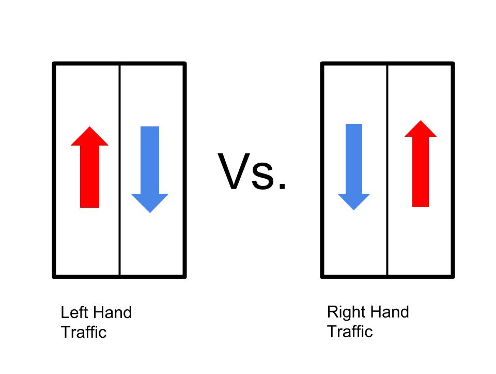Currently, only about 30% of the world's countries and territories implement left-hand traffic (LHT), which accounts for about a sixth of the world's area, 35% of its population and 25% of its roads. The rest of the world uses RHT (right-hand traffic) for their roads.
Uganda follows the LHT rule, which is the practice of keeping to the left side of the road, in bidirectional traffic. In countries where one drives on the left-hand side of the road, the cars are built so that the driver sits on the right-hand side of the car. The steering wheels of these cars are located on the right-hand side, and they are known as right-hand drive (RHD) vehicles. People go around the roundabouts in the clockwise direction in such countries.

Historically, all traffic used to follow the left-hand traffic rule. Most people, being right-handed, found it easier to mount their horses from the left. It made sense to climb from the side of the road rather than from the middle, hence they chose the left-hand rule. At the same time, the right hand would be free for greetings or for defense (by holding a sword).
However, when Napoleon came to power, he began changing the left-hand rule to right-hand to suit his own requirements. He being left-handed, preferred to stay on the right side of the road with his sword braced in his left-hand, ready for attack or defense. So he introduced the right-hand system in countries or territories he conquered.
The French Revolution also contributed to popularizing the right-hand rule. The farmers in France were earlier forced to travel on the right side of the road while the aristocrat travelled on the left side. Post the revolution, travelling on the right side became a symbol of freedom that quickly spread to other European countries.

However, the United Kingdom was not affected by this change, being an isolated island nation, just like other island nations, like Japan and Indonesia. During colonization, Britain introduced LHT to the East Africa Protectorate (now Kenya, Tanzania and Uganda), Rhodesia, and the Cape Colony (now Zambia, Zimbabwe and South Africa). Most countries and territories that were formerly British colonies, like Uganda, still drive on the left-hand side of the road.
Presently, about 41 countries and territories in Africa follow right-hand traffic (RHT), while only 14 African countries and territories practice left-hand traffic (LHT).
If you are looking to buy your next car in Uganda, visit Carkibanda.com, where you will find thousands of RHD vehicles to choose from. Carkibanda.com offers not just vehicles, but also insurance, loans and spare parts for your vehicles at very affordable prices.
Here is a list of countries for both RHT and LHT in Africa.
Countries following RHT in Africa
1 Algeria
2 Angola
3 Benin
4 Burkina Faso
5 Burundi
6 Cameroon
7 Cape Verde
8 Central African Republic
9 Chad
10 Comoros
11 Côte D'Ivoire
12 Democratic Republic Of Congo
13 Djibouti
14 Egypt
15 Equatorial Guinea
16 Eritrea
17 Ethiopia
18 Gabon
19 Gambia
20 Ghana
21 Guinea
22 Guinea-Bissau
23 Liberia
24 Libya
25 Madagascar
26 Mali
27 Mauritania
28 Morocco
29 Niger
30 Nigeria
31 Republic Of Congo
32 Rwanda
33 Senegal
34 Sierra Leone
35 Somalia
36 South Sudan
37 Sudan
38 São Tomé And Príncipe
39 Togo
40 Tunisia
41 Western Sahara
Countries following LHT in Africa
1 Botswana
2 Eswatini (Swaziland)
3 Kenya
4 Lesotho
5 Malawi
6 Mauritius
7 Mozambique
8 Namibia
9 Seychelles
10 South Africa
11 Tanzania
12 Uganda
13 Zambia
14 Zimbabwe


